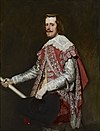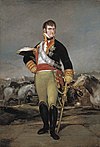
The Viceroyalty of New Granada was the name given on 27 May 1717, to the jurisdiction of the Spanish Empire in northern South America, corresponding to modern Colombia, Ecuador, and Venezuela. Created in 1717 by king Felipe V, inside of a new territorial control policy, it was suspended in 1723 due to financial problems and was restored in 1739 until the independence movement suspended it again in 1810. The territory corresponding to Panama was incorporated later in 1739, and the provinces of Venezuela were separated from the Viceroyalty and assigned to the Captaincy General of Venezuela in 1777. In addition to these core areas, the territory of the Viceroyalty of New Granada included Guyana, southwestern Suriname, parts of northwestern Brazil, and northern Peru.
A viceroy is an official who runs a polity in the name of and as the representative of the monarch of the territory. The term derives from the Latin prefix vice-, meaning "in the place of" and the French word roy, meaning "king". A viceroy's territory may be called a viceroyalty, though this term is not always applied. The adjective form is viceregal, less often viceroyal. The term vicereine is sometimes used to indicate a female viceroy suo jure, although viceroy can serve as a gender-neutral term. Vicereine is more commonly used to indicate a viceroy's wife.

Upper Peru is a name for the land that was governed by the Real Audiencia of Charcas. The name originated in Buenos Aires towards the end of the 18th century after the Audiencia of Charcas was transferred from the Viceroyalty of Peru to the Viceroyalty of the Río de la Plata in 1776. It comprised the governorships of Potosí, La Paz, Cochabamba, Chiquitos, Moxos and Charcas.

The Viceroyalty of Peru was a Spanish imperial provincial administrative district, created in 1542, that originally contained modern-day Peru and most of Spanish Empire South America, governed from the capital of Lima. Peru was one of the two Spanish Viceroyalties in the Americas from the sixteenth to the eighteenth centuries.
A viceroyalty was an entity headed by a viceroy. It dates back to the Spanish colonization of the Americas in the 16th century.

The Argentine War of Independence was fought from 1810 to 1818 by Argentine patriotic forces under Manuel Belgrano, Juan José Castelli and José de San Martín against royalist forces loyal to the Spanish crown. On July 9, 1816, an assembly met in San Miguel de Tucumán, declared full independence with provisions for a national constitution.

The Viceroyalty of the Río de la Plata was the last to be organized and also the shortest-lived of the Viceroyalties of the Spanish Empire in the Americas.

Located principally in the city centre or Cercado de Lima and Rímac areas, the Historic Centre of Lima is among the most important tourist destinations in Peru.

Francisco Álvarez de Toledo, also known as The Viceroyal Solon, was an aristocrat and soldier of the Kingdom of Spain and the fifth Viceroy of Peru. Often considered the "best of Peru's viceroys," he brought stability to a tumultuous viceroyalty of Spain and enacted administrative reforms which changed the character of Spanish rule and the relationship between the indigenous Native Americans of the Andes and their Spanish overlords. With a policy called reductions, Toledo forcibly relocated much of the Indian population of Peru and Bolivia into new settlements to facilitate Christianization, to collect tribute and taxes, and to gather Inca labor to work in mines and other Spanish enterprises.

José Antonio de Mendoza Caamaño y Sotomayor, 3rd Marquis of Villagarcía de Arousa was a Spanish colonial administrator in the Americas. From February 4, 1736 to December 15, 1745 he was Viceroy of Peru.

The history of Lima, the capital of Peru, began with its foundation by Francisco Pizarro on January 18, 1535. The city was established on the valley of the Rímac River in an area populated by the Ichma polity. It became the capital of the Viceroyalty of Peru and site of a Real Audiencia in 1543. In the 17th century, the city prospered as the center of an extensive trade network despite damage from earthquakes and the threat of pirates. However, prosperity came to an end in the 18th century due to an economic downturn and the Bourbon Reforms.

The Governorate of New Castile was the gubernatorial region administered to Francisco Pizarro in 1528 by King Charles I of Spain, of which he was appointed governor.

The Colombian Declaration of Independence refers to the events of July 20, 1810, in Santa Fe de Bogota, in the Spanish colonial Viceroyalty of New Granada. They resulted in the establishment of a Junta de Santa Fe that day. The experience in self-government eventually led to the creation of the Republic of Colombia.(Note: The initial ambitious area, in accordance with the Viceroyalty of New Granada and Captaincy of Venezuela, included much more than current Colombia; to differentiate it, historians call this supra-nation: Republic of Gran Colombia.)

The dissolution of the Viceroyalty of the Río de la Plata was the independence and breaking up of the Spanish colony in South America. Most of the viceroyalty is now part of Argentina, and other regions belong to Bolivia, Brazil, Paraguay and Uruguay.
This page is based on this
Wikipedia article Text is available under the
CC BY-SA 4.0 license; additional terms may apply.
Images, videos and audio are available under their respective licenses.




































































